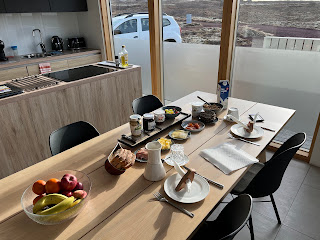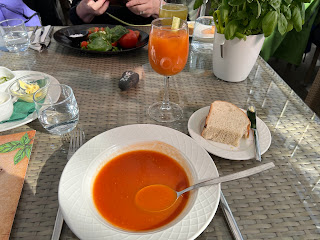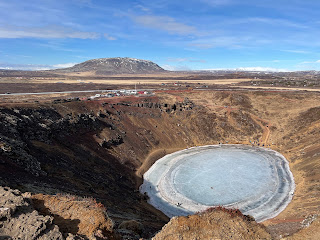Sunday, April 7th:
The next morning we woke up to a beautiful breakfast prepared by Joyce. She put out slice of bread from the Baka Baka bakery, Nutella, crunchy peanut butter, turkey, salmon, cheese, granola, fruit, and my new favorite thing, Skyr!
Skyr is thick and creamy Icelandic yogurt that been made on the island for over 1000 years! Even the plain version is delicious and it is high in protein and low in fat.
After breakfast we headed out to see the Skálholtsdómkirkja (Skálholt Cathedral).
This beautiful cathedral was built in 1956 exactly 900 years after the diocese was founded. The nine churches that had previously been here had all been destroyed by disasters. Thirty-two Catholic bishops sat here until the Reformation to Lutheranism in 1540.
The interior of the cathedral contains 25 colorful stained glass windows and a large mosaic behind the alter which depicts Christ.
[The mosaic is made from local stones]
Under the cathedral is a small museum where artifacts are on display from the archaeological excavation that took place in the 1950s before the current cathedral was built.
A sarcophagus was found in August 1954 during the excavation for the foundations of the new cathedral. This sarcophagus contains the remains of our bishop Páll Jónsson, who died on November 29, 1211.
A 13th-century tunnel leads to the crypt/cellar. In the olden days, the tunnel was used as a tunnel between the Cathedral and the school.
[Grounds of the excavation]
[You can see the foundations of other buildings]
We left the Skálholtsdómkirkja, drove through the town of Laugarás, crossed the Laugarás bridge (over the Hvítá river), made a big loop through the tundra, saw a lot of small family farms, drove through the town of Flúðir, and ended up at the Bræðratungukirkja.
[Laugarás bridge]
[Hvítá river]
[Farms]
[Horses]
[Swans]
[Farm]
[Bræðratungukirkja]
This cute church was built in 1911, but there were churches built here dating back to the 10th century.
The graves in Iceland are lit up with lanterns or lights. This is a way for people to remember their loved ones. Like I said before, light is very important to the Icelandic people, especially during the polar nights.
[Grave from 1052]
[I wanted to show how windy it was!]
After taking our pictures of the Bræðratungukirkja we headed to Reykholt to see the greenhouses. Yes! Greenhouses! In the 1920s Icelanders figured out how to use the geothermal energy to heat greenhouses so they could grow their own food. This really took off in the 1960s and now Iceland is VERY self sufficient. They grow fruits, vegetables, garnish, and even flowers in these large greenhouses. Since it is so cold in Iceland there are very few bugs, so there is no need for pesticides. Everything that is grown here is fresh, organic, and delicious!
We stopped at the Friðheimar Tomato Greenhouse for lunch and I was blow away!
We actually ate inside the greenhouse where the tomatoes are growing and the bees are flying around! That's right! BEES! They brought in bees to pollinate the flowers. It's mind blowing!
[Bee hives]
[The bees are pretty small and they don't have stingers]
Joyce took us for a quick tour through the greenhouse before we found our table. Everything on the menu is made fresh from the tomatoes that are grown in this greenhouse.
We started with a bloody Mary and Josh got a tomato beer (he said it was pretty good). I got the unlimited tomato soup and homemade bread, Josh got a small pizza with fresh mozzarella, and Joyce got the heirloom and burrata cheese dish.
[Unlimited tomato soup and bread]
[Heirloom and burrata cheese]
[Small pizza with fresh mozzarella]
Everything was so fresh and delicious!
Joyce told us that all of the desserts were delightful so we decided to get one of each!
[Sorbet and cheesecake]
[Green tomato and apple pie]
The desserts were amazing and they were served in flower pots! How adorable!
We then went on a drive by two beautiful lakes. We stopped briefly at
Laugarvatn Fontana, which is a lakefront spa that has geothermal pools.
Next we went out to the Laugarvatnshellar to learn about "The Cave People." When Joyce first mentioned the Cave People I got excited and thought they were native people who lived in caves. Then I remembered that Iceland doesn't have a prehistoric native population. So... what is this all about?
We arrived in a valley and walked up a hill where we found this:
A cute little shelter built into the rocks! The shelter consists of two caves that are concealed behind the aluminum panels. There is a larger cave behind the white door on the right (below the chimney) and a smaller cave behind the small door on the far left side (you can barely see it in this picture because it is down a few steps).
The shelter is natural, but it was dug out and made larger by Irish monks around 874 AD. It was used by various shepherds over the years and in 1910 a couple moved in and lived there for 11 months. During that time they installed a living room and a kitchen in the bigger cave and kept sheep in the smaller cave.
[Entrance to the smaller cave - used for animals]
[Interior of larger cave]
[Interior of smaller cave]
In 1918 another couple moved into the cave and lived there for four years. They had three kids while living in the cave and two of them were born in the cave!
During the high season you can book a tour and enter the cave. It was not what I was expecting, but still very cool!
[View of the valley from the shelter]
Joyce suggested we climb up above the shelter and get some pictures of the valley. It was so crazy windy up there and I had to sit down so I didn't fall over!
We then drove to the
Kerið Crater, which is located just down the road from our cottage. Kerið was a cone volcano which erupted and emptied its magma reserve. Once the magma was depleted, the weight of the cone collapsed into the empty magma chamber. What's left behind is a volcanic crater lake. This all happened 6500 years ago, which is very young geologically speaking.
Joyce dropped us off at the entrance and we hiked around the rim and then went down to the lake.
[Volcano rim with the frozen lake]
Yes, it was very windy!
[Pano of the crater lake]
After hiking out of the crater we jumped back in the rental car and Joyce drove us to Eyrarbakki. This cute little fishing town has a population of 570 people and is home to the only high security prison, Litla-Hraun, in all of Iceland. There are currently 45 people incarcerated there. For reference there are only 153 people currently incarcerated in all of Iceland. Iceland is one of the safest countries and crime is almost non-existent.
From Eyrarbakki we drove up the cost to where the Ölfusá river empties into the Atlantic Ocean.
The black sand beach was beautiful, but I can see why people don't ever swim in the oceans here, even in the summer. The water is cold and rough!
We then drove back to Selfoss for dinner and then back to our cottage.
After we got home I downloaded an app for the Northern Lights and checked the Iceland weather website. We had a low chance to see the northern lights, but the sky was clear, so we decided to stay up and watch the sky.
First, we had a beautiful sunset.
Then we had Blue Hour, which is when everything turns blue after sunset.
[Green means you have a 10 to 29% chance of seeing the Northern Lights]
Someone in Reykjavík reported seeing the lights!
Around midnight we started seeing a green haze along the horizon and above us. We had to wait a little longer, but then the lights showed up!
I can't believe we got to see the Northern Lights! What a great way to start the trip!











































































































No comments:
Post a Comment